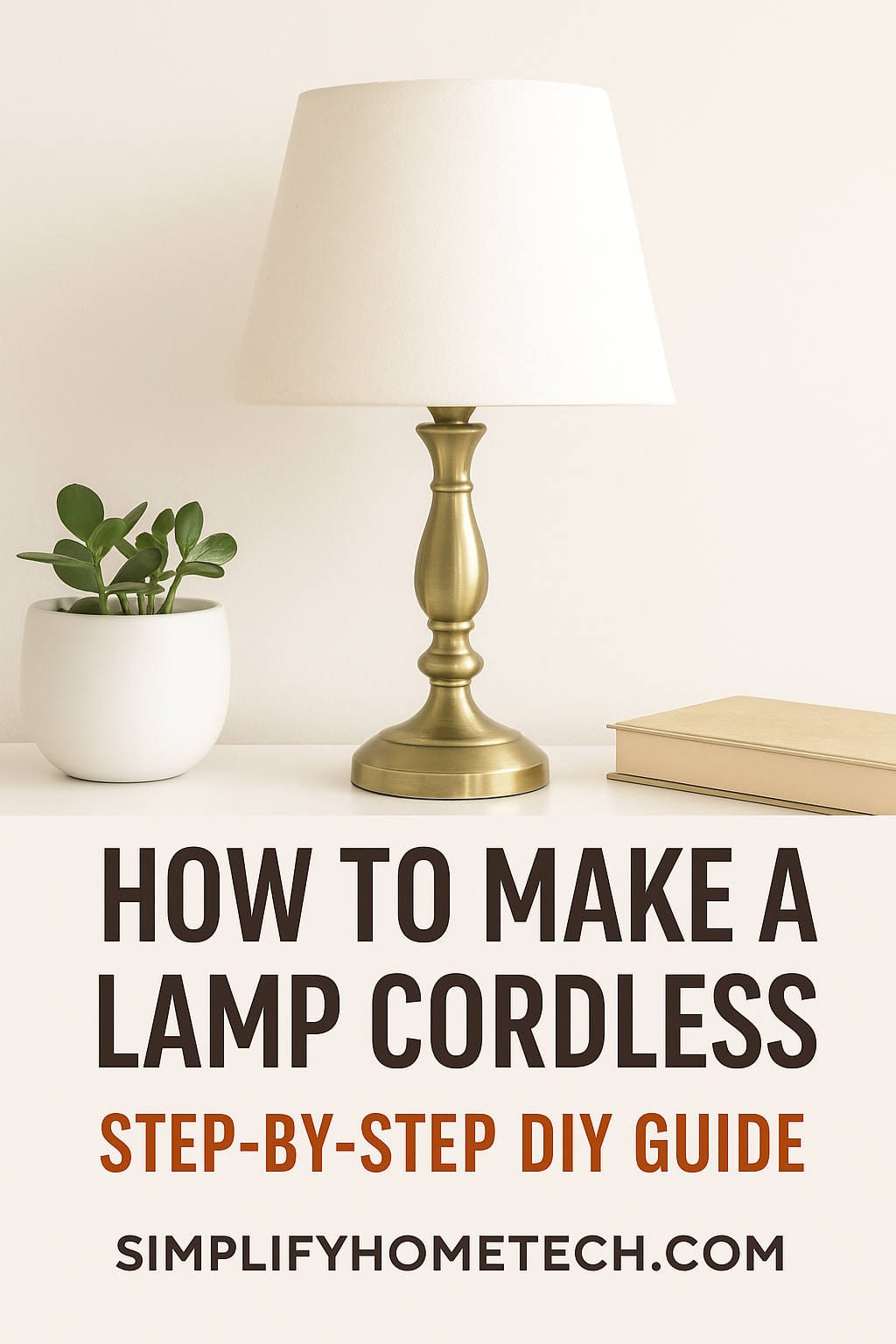Lamps bring warmth, style, and character to any room. But let’s be honest—those dangling cords can be a real eyesore. Whether it’s ruining the aesthetic, becoming a tripping hazard, or limiting where you can place your lamp, cords often cause more trouble than they’re worth. That’s where cordless lamps come in.
In this DIY guide, you’ll learn how to turn a traditional corded lamp into a fully functional cordless version. Whether you’re an avid DIY enthusiast or just someone looking to upgrade a lamp for a specific corner of your home, this guide will walk you through the entire process in a clear, easy-to-follow way.
Why Go Cordless?
Before diving into the how-to, let’s explore why cordless lamps are worth the effort.
1. Design Freedom
No cords mean you can place your lamp wherever you want—on shelves, in the middle of a room, or even outside for special occasions.
2. Cleaner Look
A wireless lamp gives any room a more streamlined and organized appearance, free from tangled cords.
3. Safety
Without cords, there’s a reduced risk of tripping or accidentally unplugging the lamp.
4. Portability
Need to move your lamp from the bedroom to the patio? No problem. A cordless design makes it much easier to relocate your lighting.
What You’ll Need: Tools & Materials Checklist
Before you begin, gather the following tools and materials. This will save you time and help everything go smoothly.
Tools:
- Small screwdriver set (flathead and Phillips)
- Wire cutters/strippers
- Hot glue gun (or strong double-sided tape)
- Drill (optional, depending on your lamp’s design)
- Soldering iron (optional for advanced users)
Materials:
- LED puck light or rechargeable LED bulb
- The lamp you want to convert
- Rechargeable battery pack (preferably USB-powered)
- USB-compatible LED light (if not using a puck light)
- Velcro strips or mounting brackets
- Heat shrink tubing or electrical tape
- Small on/off switch (if your battery doesn’t include one)
Pro Tip: Use quality materials and a rechargeable LED light to ensure longer lifespan and better performance.
Step-by-Step Instructions to Make a Lamp Cordless
Let’s walk through each stage of the conversion process. Take your time, follow each step carefully, and don’t hesitate to adapt things to fit your particular lamp or preferences.
Step 1: Choose the Right Light Source
First, pick a battery-powered light source suitable for your lamp. Not all lights are battery-friendly, especially older incandescent bulbs that consume too much energy.
Option 1: LED Puck Lights
Small, disk-shaped lights that are typically adhesive-backed. They often come with a built-in battery and remote control.
Best for: Small table lamps, decorative lighting
Option 2: Rechargeable LED Bulbs
Some LED bulbs come with built-in batteries and are rechargeable via USB. These fit into standard light sockets.
Best for: Standard-size table or floor lamps
Option 3: USB LED Lights with External Battery Pack
This setup allows for more brightness and control, ideal for lamps used for reading or general lighting.
Best for: Larger lamps, functional lighting
Step 2: Disassemble the Lamp
Important: Always unplug the lamp and ensure it’s not connected to any power source.
- Remove the lampshade and light bulb.
- Open the lamp base (if possible) using a screwdriver.
- Cut and remove the power cord from the lamp.
- Remove any internal components you won’t need, like ballasts, switches, or old sockets.
Now you have a clean slate to work with.
Step 3: Prepare the Power Supply
You’ll need to determine how your light will be powered. Here are a few popular options:
Built-in Battery (Puck Light)
These require minimal wiring and are easy to install. Just attach it to the lamp’s interior with adhesive.
External USB Battery Pack
If you’re using a USB-powered bulb, plug it into a rechargeable battery bank. Use Velcro to mount the battery inside or underneath the lamp base.
Tips:
- Choose a battery with at least 5,000 mAh capacity for longer run times.
- Make sure it has overcharge and short-circuit protection.
Step 4: Modify the Lamp Housing (If Necessary)
Some lamps may need minor tweaks to fit the new components. Use a drill to:
- Create holes for running USB cables
- Mount switches or secure brackets
Use the hot glue gun or mounting brackets to secure internal components like the puck light or battery pack. Make sure everything fits snugly and safely.
Step 5: Connect the Components
How you connect the components depends on your chosen setup:
Using a Puck Light
- Place the light inside the lamp shade or base.
- Make sure it’s facing outward to maximize illumination.
- Use adhesive or Velcro to secure it in place.
Using a USB Bulb and Battery
- Screw the bulb into a USB-compatible socket or adapter.
- Connect it to the battery pack via USB cable.
- Mount the battery pack inside the lamp base.
- Add an inline on/off switch if necessary.
Use heat shrink tubing or electrical tape to secure and insulate any exposed wires.
Step 6: Test Your Cordless Lamp
Before putting everything back together, run a quick test:
- Turn on the light using the switch or remote.
- Check brightness and battery duration.
- Make sure all parts are secure and not overheating.
Troubleshoot any issues before final assembly. If it doesn’t light up, double-check your wiring and battery charge.
Step 7: Final Assembly and Decoration
Once everything is working:
- Reassemble the lamp base and shade.
- Conceal the battery pack and cables using fabric or decorative elements.
- Add felt pads under the lamp if needed for stability.
Your lamp is now cordless and ready to go!
Creative Variations & Ideas
Ready to take things up a notch? Here are some bonus upgrades:
1. Add Smart Features
Use a smart puck light or smart bulb compatible with voice assistants like Alexa or Google Home.
2. Go Solar
Attach a small solar panel to charge the battery during the day. Ideal for patio or garden lamps.
3. Install Motion Sensors
Perfect for hallway or bathroom lamps. The light turns on automatically when it detects movement.
4. Create a Charging Station
Design your lamp base to include USB ports for charging phones or tablets, combining lighting and utility.
Common Mistakes to Avoid
Avoid these pitfalls to ensure your project goes smoothly:
- Using Incandescent Bulbs: They draw too much power for battery use.
- Forgetting Heat Dissipation: Ensure components don’t overheat in enclosed spaces.
- Choosing Weak Batteries: A weak battery will need constant recharging.
- Not Securing Components: Loose batteries or lights can become fire hazards.
Battery & Runtime Recommendations
| Battery Capacity | Estimated Runtime for 5W LED |
|---|---|
| 2,000 mAh | ~3 to 4 hours |
| 5,000 mAh | ~8 to 10 hours |
| 10,000 mAh | ~15 to 20 hours |
Note: Always follow manufacturer guidelines for charging and discharging.
Cost Breakdown
| Item | Estimated Cost (USD) |
|---|---|
| LED puck light (3-pack) | $10 – $20 |
| USB battery pack (10,000 mAh) | $15 – $30 |
| USB LED bulb or strip | $5 – $15 |
| Mounting hardware & adhesives | $5 – $10 |
| Misc tools (tape, wire, etc.) | $5 – $10 |
| Total | $40 – $85 |
Compared to buying a high-end cordless lamp, this DIY project is cost-effective and customizable.
Final Thoughts
Transforming a corded lamp into a cordless version is not just about aesthetics—it’s about functionality, safety, and personalization. With just a few tools and some creativity, you can upgrade any lamp to suit your space, style, and needs.
This project is great for beginners and experienced DIYers alike. It opens the door to countless lighting possibilities without being restricted by outlet locations.
So grab that old lamp from the attic, give it a cordless makeover, and enjoy the freedom of wireless lighting.
Have questions or want to share your cordless lamp creation? Leave a comment below or tag us on social media with your project photos!
You might also like,

